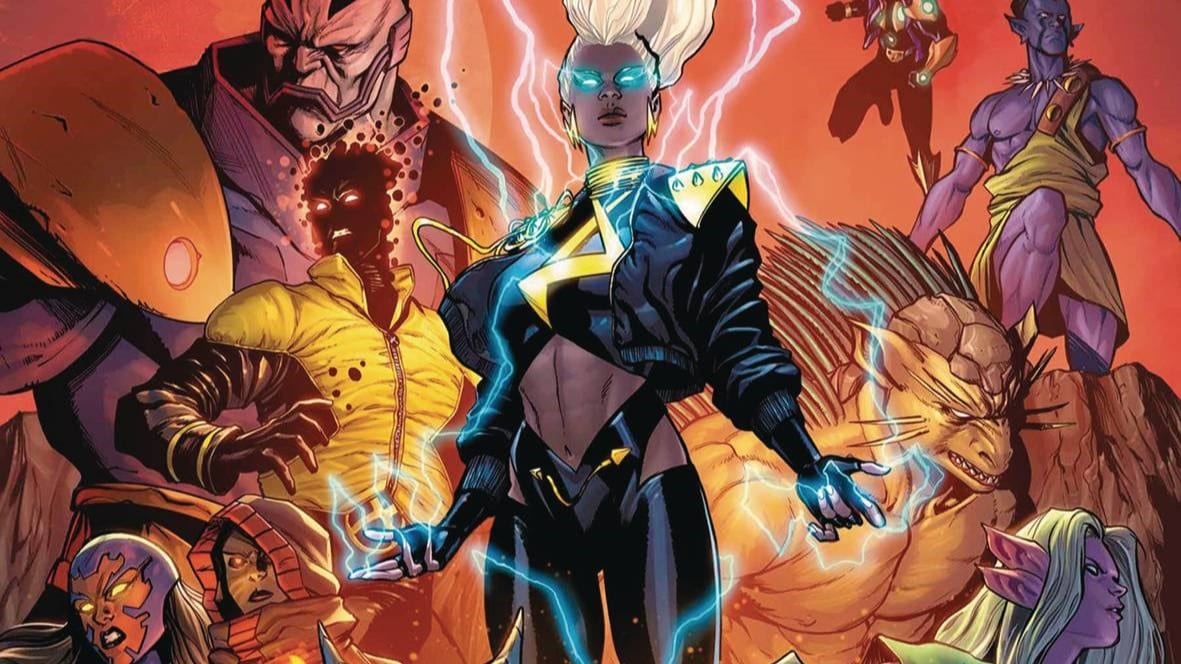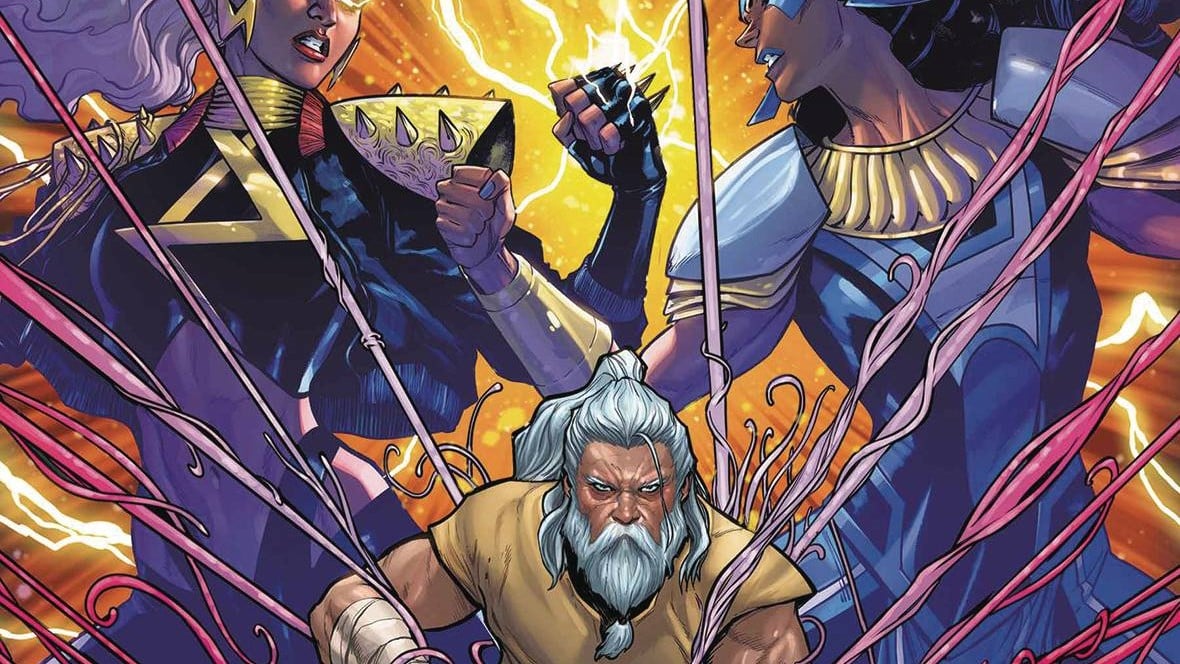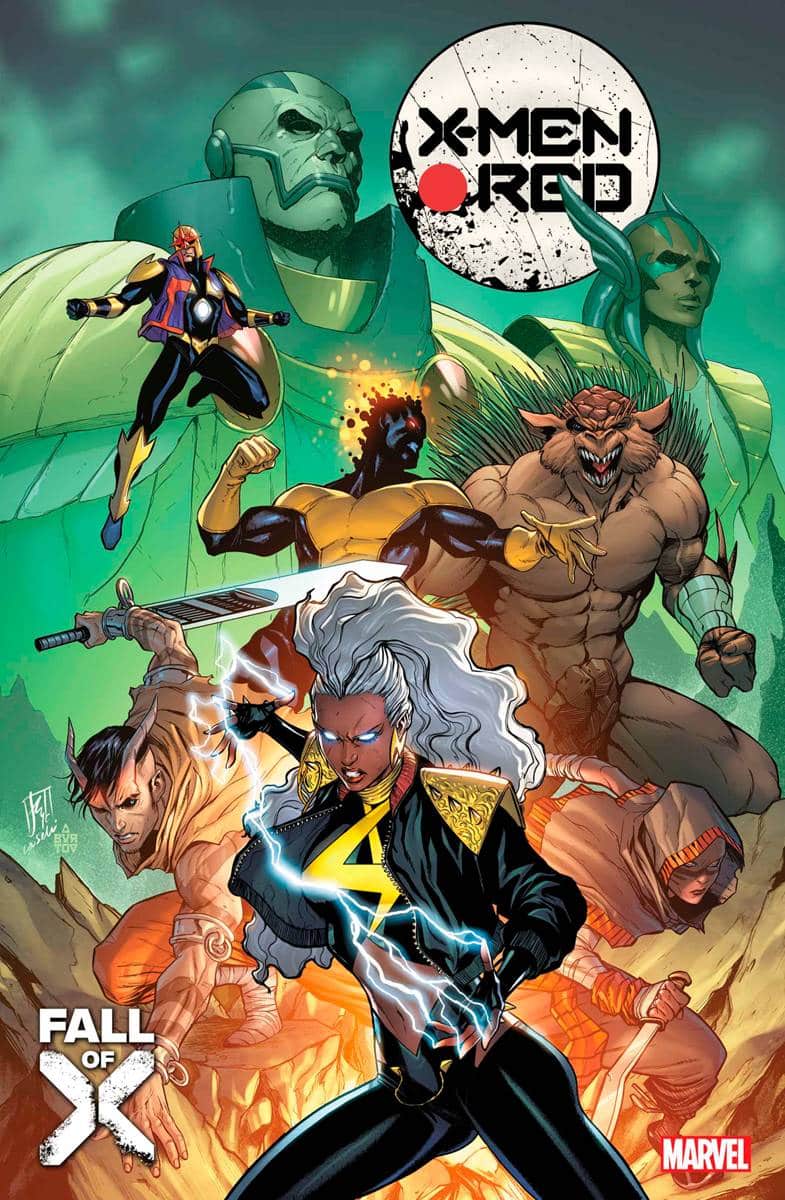Floating dead-center in the eye of the Mutant Kaiju Kaorak (a not so subtle re-arranging of Krakoa), Storm floats, irises electric blue, electricity teeming from her hands, threatening Genesis with the good time of a fight. This is as audacious as it is silly: this manifestation of mutant cooperation, teeming for a fist fight where words would probably be more effective, but not nearly as fun.
I love it here. This, as they say, is Comics.
We are one issue away from the completion of X-Men Red, and another four issues from the the culmination of Ewing’s Krakoan story with the forthcoming Resurrection of Magento. So, if we’re going to go out, it stands to reason that we should go out with a bang.
And there are quite a few bangs in this book.
The reintroduction of Apocalypse as a focused, threatening, amoral character; the dissolution of temptation from Uranos; the Captain Planet-like unification of mutant powers; the re-emergence and subjugation of Gabriel Summers: there’s, as always, a lot to examine, delivered in a way that’s easy to digest and even easier to appreciate. And while it’s hard to appreciate individual issues without the full context of the whole story, this specific issue seeds enough action and intrigue to capture the attention of those with only a passing interest in Krakoa.
Where the mutants will go from here is anyone’s guess, a guess fans would be wise to judge based on more than fearful conjecture. But we are in the here and now, and the here and now — here in X-Men Red #17 — is a great place for fans to reside.
Righteous Return(s)
It’s great to have the Big Blue Daddy back in action at a time when his decisiveness would be more than appreciated. Yet, the character feels a bit regressed in his words and actions, compared to where we left him a few years ago. Where X of Swords fleshed out a character whose seemingly genocidal inclinations were revealed to be bruising tests to ensure his people were strong enough to survive; a dedicated father and husband, for whom love, not annihilation (literally and figuratively) was his motivation.
Yet here we see him scheming, robbing Vulcan of his self determination, using him like he’s used so many horsemen in the past to achieve his sordid ends. Is it better because Vulcan himself is an unrepentant genocider too? Is he more noble to (“passively”) fight against his equally germicidal wife?
Do the ends of his apparent goal — the preservation of Arakko — justify his regressively aggressive means?
Is he really that much different than Uranos?
All questions we hope to see answered eventually.
Here, however, we see him use might to unbind Gabriel and magic to rebind him with his ragtag group of supporters, including the somewhat subdued return of Redroot and Sunfire. If you haven’t been keeping up with the Marvel Unlimited story, Sunfire, on a quest in Otherworld to find Redroot, nearly perishes, until Redroot takes, uh, root in him, keeping him alive and delivering the Krakoan counterpart back to our dimension. I suspect most haven’t kept up with the app-only story, relegating his triumphant return to what feels like a mere footnote. The characters — and their stories — deserve better, though that’s not necessarily the fault of anyone attached to Red.
Regardless, the team is all here, ready and raring to rumble — just like another young-ish(?) mutant who’s all too eager to exact his revenge.
Family Business
Fidelity to family — both natural and found — finds itself the focus for a few characters in X-Men Red #17. There is Death, who, upon killing his sister for her misaligned morals, looks to his father for compassion, only to find mildly dismissive acknowledgement (though telling Death to find meaning in life is kind of awesome). We see the found family of Arrakki refugees, rebuilding yet again, mourning their losses, preparing yet again to withstand another onslaught. (Mutant fans often bemoan how many tragedies the X-Men have had to face over the years. It feels like the Arakki have dealt with a similar level of tragedy in just 2-3 years. Morbidly impressive to be honest.).
Most prominent in this issue is Jon Ironfire. His fidelity to White Sword feels awkwardly sordid, like a sociopathic version of Stockholm Syndrome: He cares for, even appreciates, his former enslaver, even as he wishes to kill White Sword for White Sword’s own benefit. His reliance on violence to solve all problems, shown both in his eagerness to kill and his eagerness to use Uranos, stands in contrast to the much more subdued, resigned desire of Storm to finish things by her own hand, with just enough force to finish things — not an embrace of death, but not a shun of killing either.
His rabid desire to fight leads Jon astray, both figuratively (as he departs from the growing Arrakkii reliance on teamwork and community) and literally, as he takes on the White Sword’s hordes on his own, coolly counting his kills, courting his former coraller. We know this decision is likely not wise, as an older, alternate universe Ironfire would admit in Sins of Sinister. Thus we wait to see how his eagerness to reunite with his brothers at arms and father will ultimately affect the rest of the grouping.
All Together Now!
Maybe the most devastating — and imposing — lines of X-Men Red #17 are delivered between Storm and Apocalypse. Storm, in shunning the violence of Uranos, notes that his violence would be unbridled, and she, “would know when to stop.”
“Yes. Yes, that’s what we tell ourselves.”
The response here is telling in so many ways; The implication that most don’t or won’t stop when they have the chance, juxtaposed with the numerous examples of Storm showing mercy when she’s had the opportunity to kill; the foreshadowing of yet another morally dubious choice on the horizon, where the temptation to do wrong for “good” reasons may outweigh the restraint she’s thus far shown. Even the facial expression of Apocalypse, forbidding as always, gives rise to the possibility of more moral danger over the horizon.
But we are in the here and now, and here, now, we see the unification of imperfect elemental avatars to create a whole being.
These pages, brilliantly composed (by artist Yildiray Çinar), harken back to SWORD #6, when Storm makes her triumphant introduction as the Regent, and X-Men Red #11, as she uses the Red Triangle psychic defense to push back on Xavier’s hubris. The grandiosity of the two page splash (followed directly by another two page splash featuring illustrations from past comics) creates an emotional collage of thoughts and feelings that are just as magnificent as when we first saw them, and just as integral to the story. This illustrative mechanic is original and effective.
This, again, is good comics.
(Also, props to Federico Blee for doing a fantastic job coloring Storm and Genesis’ brown skin, though the blue Arakki sky feels maybe a bit misplaced. It’s X-Men Red for a reason.)
And thus we end where we begin, with Storm in the eye of the fight, fright apparent on the face of her rival, readying for one last tussle for the soul of the people.
There’s only one more issue left, and what feels like so much more story to tell. Thus as much as we may miss all the stories that could be, we can be forever thankful for the brilliant stories that are.
Stories that, above all, are just plain good comics.
A proud New Orleanian living in the District of Columbia, Jude Jones is a professional thinker, amateur photographer, burgeoning runner and lover of Black culture, love and life. Magneto and Cyclops (and Killmonger) were right.
Find more of Jude’s writing here.






